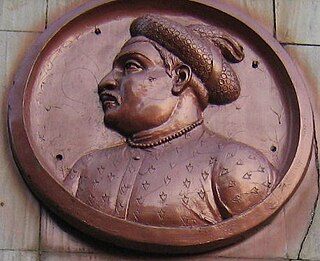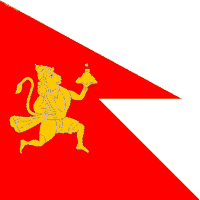
Bajirao I, born as Visaji, was the 7th Peshwa of the Maratha Confederacy.

Peshwa was second highest office in the Maratha Confederacy, next in rank and prestige only to that of the Chhatrapati. Initially serving as the appointed prime minister in the Maratha empire, the office became hereditary after the death of Shahu in 1749. During the reign of Shahu, the office of Peshwa grew in power and the Peshwas came to be the de facto rulers of the Maratha empire. However following the defeat of the Marathas in 1761, the office of the Peshwa became titular as well and from that point onwards served as the ceremonial head of the Confederacy underneath the Chhatrapati.

The Central India Agency was created in 1854, by amalgamating the Western Malwa Agency with other smaller political offices which formerly reported to the Governor-General of India. The agency was overseen by a political agent who maintained relations of the Government of India with the princely states and influence over them on behalf of the Governor-General. The headquarters of the agent were at Indore.
Dhar is a city located in Dhar district of the Malwa region in the state of Madhya Pradesh, India. The city is the administrative headquarters of the Dhar district. Before Indian independence from Great Britain, it was the capital of the Dhar princely state.
Malwa Agency was an administrative section of British India's Central India Agency. The headquarters of the political agent was at Mandsaur (Mandasor) / Neemuch (Nimach). The other chief towns of the region were : Ratlam and Jaora.

Gwalior state was a semi-autonomous Maratha state. It was centred in modern-day Madhya Pradesh, arising due to the rise of the Maratha Empire and fragmentation of the Mughal Empire.
Betma is a town and a nagar panchayat in Indore district in the state of Madhya Pradesh, India.

Ranoji Shinde was the founder of the Scindia dynasty, a Maratha clan that produced outstanding Maratha military commanders during the 18th century. Later the Scindia served as vassals of the British from the northern Princely state of Gwalior.

The history of Madhya Pradesh can be divided into three periods - the ancient period, the medieval period and modern period.

Jaora State was a 13 gun-salute princely state of the British Raj. It was part of the Malwa Agency.

Sailana State was an 11 gun salute princely state in India, part of the Malwa Agency of Central India during the British Raj. The state enjoyed an estimated revenue of Rs.5,00,000.
Kampel is a panchayat village in the Indore block of the Indore district, Madhya Pradesh, India. It was the headquarters of a pargana in Mughal Empire before the administrative center of the region was shifted to Indore city under the Holkars of the Maratha Empire.

The following list includes a brief about the titles of nobility or orders of chivalry used by the Marathas of India and by the Marathis/Konkanis in general.

Dewas State was a territory within Central India, which was the seat of two Maratha princely states during the British Raj. After the Maratha conquest of Central India, Dewas was divided into two states - Dewas Junior ruled by Jivaji Rao Puar and Dewas Senior ruled by Tukoji Rao Puar. On 12 December 1818, the 2 Dewas States became British protectorates.

Dewas Junior was established by Jivaji Rao I Puar in 1728 during the Maratha conquest of Central India. It was a 15-gun salute Maratha princely state. On 12 December 1818, it became a British protectorate.

Dewas Senior was established by Tukoji Rao I Pawar during the Maratha conquest of Central India. It was a 15 Gun Salute Maratha princely state. On 12 December 1818 it became a British protectorate.

Indore State, also known as Holkar State, was a kingdom in India. Its rulers belonged to the Maratha Holkar dynasty. After 1857, Indore became a 19-gun salute princely state under the British Raj.
Kenud is a village of the Punasa tehsil of Khandwa district, in Madhya Pradesh state, India. The village is almost three hundred years old. Which was founded around 1700 AD by Joraji Singh Badal. Most of the people of the village depend on agriculture, workers and youth are dependent on the nearby city of Mundi and Shree Singaji Thermal Power Project for employment.
This page is based on this
Wikipedia article Text is available under the
CC BY-SA 4.0 license; additional terms may apply.
Images, videos and audio are available under their respective licenses.












